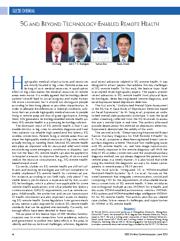5G and Beyond Technology-Enabled Remote Health
Di Zhang, Joel J. P. C. Rodrigues, Yunkai Zhai, Kaoru Sezaki
2021
IEEE wireless communications
H igh-quality medical infrastructures and resources are mostly located in big cities. Remote areas are lacking of such medical resources. A rapid siphon effect of big cities makes the medical resources of remote areas even worse. It is widely agreed that technology development should lead to social progress and make human life more convenient; but it should not distinguish people according to their living places or any other characteristics. In order to alleviate the diff erences in medical
more »
... itions, solutions that can provide high-quality medical services to people living in remote areas are thus of great signifi cance. Among them, fi fth generation technology-enabled remote health systems (5G remote health) is a promising technology solution. The dominant merit of 5G remote health is that it can enable doctors in big cities to remotely diagnose and treat their patients via reliable high speed and low latency 5G wireless connections. Patients living in remote areas thus can share the high-quality medical resources of big cities without actually moving or traveling there. Second, 5G remote health also plays an important role for rescue and relief work while encountering some emergency conditions or disasters. Last but not the least, 5G remote health can also be applied to in-hospital scenarios to improve the quality of service and reduce the resource consumption, e.g., 5G remote healthbased e-ward round. Currently, studies on 5G remote health are still not suffi cient, and existing technologies are still not competent to widely implement 5G remote health for commercial use. For instance, according to our field trials, only about 7 ms stable latency performance is experienced by the current 5G technologies, which is almost non-applicable for some remote health applications with ultra-reliable low latency communications (URLLC) requirements, such as remote surgery. Additionally, the protection and secure transmission of health information are also important issues on deploying 5G remote health. Some legislation from governments across nations is also required for uniform 5G remote health standards that can be applied internationally. Currently, not enough eff orts have been devoted to these topics. The purpose of this feature topic of IEEE Wireless Communications was to invite researchers from academia, industry and government to publish their latest eff orts in this area, to identify and discuss technical challenges, solutions, legislation and recent advances related to 5G remote health. It was designed to attract papers that address the key challenges of 5G remote health. To this end, the feature topic finally accepted three high-quality papers. The papers present recent advances in 5G remote health from physical layer technologies, deep learning-based remote diagnosis, and facial expression-based depression detection. The first article, "Undisturbed Mental State Assessment in the 5G Era: A Case Study of Depression Detection based on Facial Expressions" by M. Yang et al., proposes an undisturbed mental state assessment prototype. It uses the facial video streaming collected from the 5G terminals to assess the user's mental state in real time. The authors afterward provide details about this method on depression detection. Experiments demonstrate the validity of this work. The second article, "Deep-Learning-Empowered Breast Cancer Auxiliary Diagnosis for 5GB Remote E-Health" by K. Yu et al., proposes a deep-learning-based breast cancer auxiliary diagnosis scheme. There are two challenging issues with 5G remote health, i.e., real time image transmission, and timely response to the remote diagnosis call. With the help of 5G wireless connections and the proposed auxiliary diagnosis method, we can always diagnose the patients from remote areas in a timely manner. It is also found that while using this method, the diagnostic accuracy for breast cancer patients in remote areas is 98.19 percent. The third article, "Integrated 3C in NOMA-enabled Remote-E-Health Systems" by X. Liu et al., focuses on the novel framework that integrates communication, control and computing (3C) for the requirements of ultra-reliable low-latency connectivity of 5G remote health. It then introduces non-orthogonal multiple access (NOMA) for e-health, and discusses NOMA-enabled autonomous robotics (NOMA-ARs) systems and NOMA-enabled edge intelligence (NOMA-EI) for 5G remote health. The authors also discuss related case studies, future research challenges, and opportunities for NOMA in 5G remote health.
doi:10.1109/mwc.2021.9491945
fatcat:v67mjagenfcurilgx7s3osswpa

